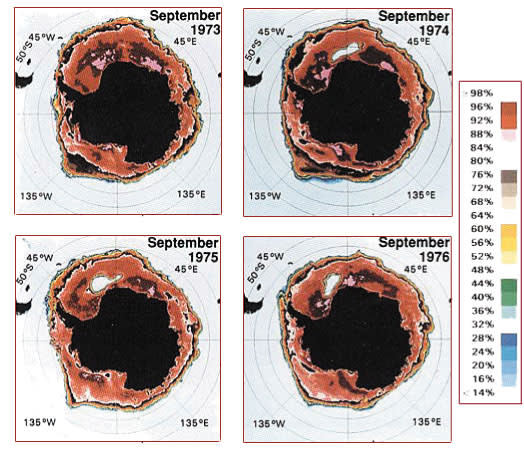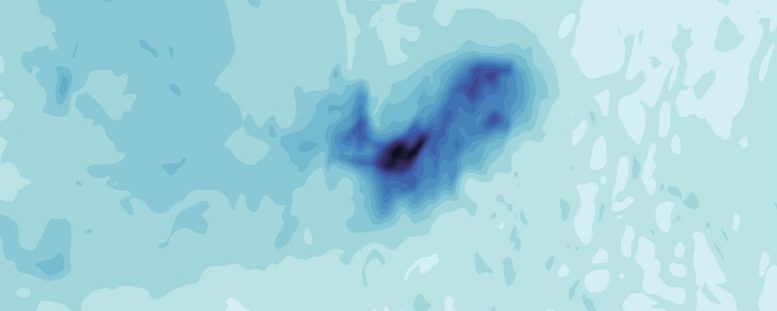A mysterious 'hole' larger than Maryland has reappeared in the middle of Antarctica after 42 years. Scientists aren't sure how it got there.
But this isn't the first time it's appeared. The hole is a type of polynya.
Polynyas are a region of open water surrounded by sea ice.
But the Weddell polynya is unlike any other.
While most polynyas form near the shore, this polynya is located hundreds of kilometers from the coast. Scientists first saw it in 1974.
Back then, the opening was as large as Oregon.
But in 1976, the opening closed up seemingly for good.
Then, in 2016, a NASA satellite spotted a small opening.
It was the first sighting of the polynya in over 40 years.
Since then, the opening has grown considerably larger.
Now, it's large enough to fit Maryland.
It's still 5X smaller than it was in the '70s.
But this polynya's reappearance is a mystery to scientists.
One expert said it was like someone had punched a hole in the ice.
From Space By Stefanie Waldek
The abnormally large 'Maud Rise polynya' has finally been explained.
Each austral winter, Antarctica undergoes a radical change.
Sea ice surrounding the continent expands outward, effectively doubling Antarctica's size.
But during the winters of 2016 and 2017, a rare hole called a polynya opened in the middle of the sea ice — one about the size of Switzerland.
And scientists have just now figured out how it came to be.
Localization of the Maud seamount with the GeoGarage platform (NGA nautical raster chart)
The hole was named the Maud Rise polynya for the seamount, or underwater mountain, located beneath it in the Weddell Sea.
According to a new study, it ultimately formed due to a combination of wind, ocean currents and underwater geography that created the perfect salty conditions to melt the sea ice.
The Maud Rise polynya goes back further than 2016.
It was first identified by Earth-sensing satellites in the 1970s, most notably during the winters from 1974 to 1976.
Scientists assumed that the polynya would return each winter, but that hasn't been the case — it has only reappeared sporadically, and for brief periods.
"2017 was the first time that we’ve had such a large and long-lived polynya in the Weddell Sea since the 1970s," study leader Aditya Narayanan, a postdoctoral research fellow at the University of Southampton in England, said in a statement.
"2017 was the first time that we’ve had such a large and long-lived polynya in the Weddell Sea since the 1970s," study leader Aditya Narayanan, a postdoctoral research fellow at the University of Southampton in England, said in a statement.
(Image credit: NASA Earth Observatory)
In 2016 and 2017, the circular ocean current in the Weddell Sea was stronger than usual.
As such, upwelling around Maud Rise brought warmer, saltier water closer to the surface.
"This upwelling helps to explain how the sea ice might melt. But as sea ice melts, this leads to a freshening of the surface water, which should in turn put a stop to the mixing," study team member Fabien Roquet, a physical oceanography professor at the University of Gothenburg in Sweden, said in the same statement.
"This upwelling helps to explain how the sea ice might melt. But as sea ice melts, this leads to a freshening of the surface water, which should in turn put a stop to the mixing," study team member Fabien Roquet, a physical oceanography professor at the University of Gothenburg in Sweden, said in the same statement.
"So, another process must be happening for the polynya to persist. There must be an additional input of salt from somewhere."
Using data from satellites, autonomous floats and tagged marine mammals, the team determined that turbulent eddies around Maud Rise brought more salt into the area, which was then transferred to the surface through a process called Ekman transport.
Using data from satellites, autonomous floats and tagged marine mammals, the team determined that turbulent eddies around Maud Rise brought more salt into the area, which was then transferred to the surface through a process called Ekman transport.
Polynya off the coast of Antarctica, near Ross Island.
Image: NASA, November 16, 2011.
Through Ekman transport, water moves at a 90-degree angle to the wind above and influences ocean currents.
"The imprint of polynyas can remain in the water for multiple years after they’ve formed," said study team member Sarah Gille, a professor at the University of California, San Diego.
"They can change how water moves around and how currents carry heat towards the continent. The dense waters that form here can spread across the global ocean."
The new study was published online (May 1) in the journal Science Advances.
The new study was published online (May 1) in the journal Science Advances.
Links :
- LiceScience : Antarctic ice hole the size of Switzerland keeps cracking open. Now scientists finally know why
- Science Alert : Scientists Solved a 50-Year Mystery of What Punched The Giant Hole in Antarctic Ice
- Science Daily : Cold Case: Scientific Sleuths Solve the Case of the Mysterious Giant Opening in Antarctic Sea Ice / Mysterious Polynya: Scientists Finally Explain Huge Hole in Antarctic Sea Ice
- Earth : Experts solve the mystery of a giant hole in Antarctic sea ice





No comments:
Post a Comment